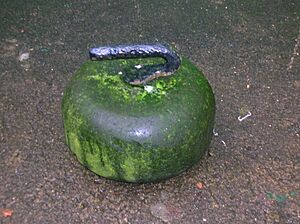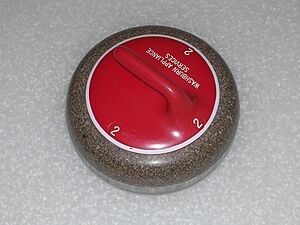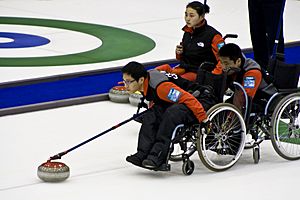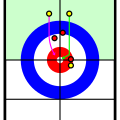Curling facts for kids

Curling games taking place during the 2005 Tim Hortons Brier
|
|
| Highest governing body | World Curling Federation |
|---|---|
| Nicknames | Chess On Ice, The Roaring Game |
| First played | In late medieval Scotland |
| Registered players | est. 1.5 million |
| Characteristics | |
| Contact | No |
| Team members | 4 per team (2 in doubles) |
| Mixed-sex | Yes; see mixed curling |
| Type | Precision and accuracy |
| Equipment | Curling brooms, stones (rocks), curling shoes |
| Venue | Curling sheet |
| Glossary | Glossary of curling |
| Presence | |
| Olympic |
|
| Paralympic | Wheelchair curling officially added in 2006 |
Curling is an exciting winter sport played on ice. Imagine a game like shuffleboard or bowls, but with heavy, polished granite stones on a special ice surface! Two teams, each with four players, take turns sliding these stones, also called rocks, towards a target area called the house. The house has four circles, like a bullseye.
Each team has eight stones, and every player gets to slide two. The main goal is to get your team's stones closer to the very center of the house than your opponent's stones. When all stones are thrown in a round (called an end), points are given to the team whose stones are closest to the center. Most games have eight or ten ends.
When a player slides a stone, they give it a gentle spin. This spin makes the stone curve as it moves, which is why it's called "curl"! Two teammates, called sweepers, can help the stone by sweeping the ice in front of it with special brooms. Sweeping makes the ice a little warmer, reducing friction. This helps the stone travel farther and straighter. Curling is all about smart strategy, teamwork, and precise throwing skills!
Contents
- The History of Curling
- Curling at the Olympics
- Essential Curling Gear
- How to Play Curling
- How Curling is Scored
- Popularity of Curling
- Good Sportsmanship
- Accessibility in Curling
- Curling Terms to Know
- Interesting facts about curling
- Champions and Major Championships
- Notable Clubs
- Images for kids
- See also
The History of Curling

Curling has a long and interesting history, starting in Scotland way back in the 1500s! We know this because old curling stones have been found with dates carved into them, like one from 1511.
The first time curling was written about was in 1541. Even famous paintings from the 1500s by Pieter Bruegel the Elder show people curling on ice in a region called Flanders. Scotland and these areas had strong connections, which helped the sport spread.
In the beginning, curlers used simple, flat stones from rivers. They didn't have handles and were all different shapes and sizes. This meant players relied more on luck than skill. People often played on frozen rivers and lakes. Later, special ponds were built just for curling.
Curling became very popular in Scotland because of the cold winters. Later, Scottish people who moved to other countries, especially Canada, took the sport with them. The Royal Montreal Curling Club, founded in 1807, is the oldest sports club still active in North America!
Today, curling is played in many countries across Europe, Asia, and even places like Brazil, Australia, and New Zealand. The first men's world championship, called the Scotch Cup, was held in Scotland in 1959. A Canadian team won that first title.
Curling at the Olympics
Curling became an official medal sport at the Winter Olympic Games in 1998. Today, there are events for men's teams, women's teams, and mixed doubles teams. The mixed doubles event was first held in 2018.
Did you know that curling actually appeared in the very first Winter Olympics in 1924? The medals from that competition were officially recognized much later, in 2002. Great Britain won the gold medal back then!
Since 1998, Canada has been very successful in Olympic curling. Their men's teams have won several gold medals, and their women's and mixed doubles teams have also won gold and other medals.
Essential Curling Gear
To play curling, you need a special ice surface, unique stones, brooms, and shoes!
The Curling Sheet
The game is played on a rectangular ice surface called a curling sheet. It's about 45 meters (146 feet) long and 5 meters (16 feet) wide. The ice is made very flat and smooth.
At each end of the sheet is the house, which is the target area. It looks like a bullseye with four circles. The very center is called the button. To score points, your stone must at least touch the outer ring of the house.
There are also two hog lines across the ice. Stones must be released before the first hog line and must pass the second one to stay in play. At the very back are the hacks, which are like starting blocks that players push off from.
Perfect Ice Conditions
Creating the perfect ice for curling is a big job! Ice makers carefully spray tiny water droplets onto the surface. These freeze into small bumps called pebble. This pebbled ice helps the stones slide better and allows them to curl (curve) as they travel. The pebble wears down during a game, so ice makers constantly check and fix it.
The Curling Stone
The curling stone, sometimes called a rock, is made of special granite. Each stone weighs between 17 and 20 kilograms (38 and 44 pounds)! The bottom of the stone has a narrow, smooth ring that touches the ice. This design, along with the pebble on the ice, helps the stone slide and curl.
A handle is attached to the top of the stone. This handle lets players grip and spin the stone when they release it. Handles are colored (often red and yellow) to tell the teams apart. Some stones even have electronic handles that light up green if the stone is thrown correctly, or red if it's not!
The Curling Broom
The curling broom, or brush, is used for two main things: to sweep the ice in front of a moving stone and to help players keep their balance when they slide.
Years ago, brooms were made of corn, like household brooms. But today, most brooms have heads made of fabric, hog hair, or horsehair. The handles are usually light and strong, made from materials like fiberglass or carbon fiber. This allows sweepers to sweep faster and press harder on the ice.
Curling Shoes
Curling shoes are special athletic shoes. One shoe, called the slider, has a slippery sole (usually made of Teflon). This is for the foot that slides forward during the throw. The other shoe, the gripper, has a normal rubbery sole to help the player push off from the hack and grip the ice.
When a player isn't throwing, they can put a slip-on gripper over their slider shoe to avoid slipping.
Other Equipment
Other gear includes:
- Curling pants: These are stretchy to allow for the movements needed to throw a stone.
- Stopwatches: Used to time how fast stones travel, which helps with strategy.
- Curling gloves and mittens: To keep hands warm and improve grip on the broom.
How to Play Curling

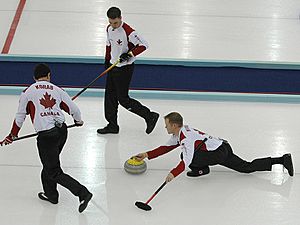
A curling game is all about scoring points by getting your stones closer to the center of the house than your opponent's stones. Players from each team take turns throwing stones. A round, called an end, finishes when all eight stones from each team have been thrown (16 stones in total). If scores are tied, extra ends are played. The team with the most points at the end wins!
Most international games have ten ends, but many recreational games have eight. Teams also have a set amount of time to make all their throws.
The Delivery
The delivery or throw is how a player slides the stone. Players, except for the team captain (the skip), take turns throwing and sweeping. When one player throws, the other two teammates sweep.
The skip is like the team's coach on the ice. They decide where the stone should go and how much weight (speed), turn (spin), and line (direction) it needs. The skip uses their broom to point out the target.
Before throwing, the stone's bottom is wiped clean, and the ice path might be swept. Any dirt can change the stone's path.
The thrower starts from the hack, pushing off with their gripper foot. They slide forward, pushing the stone ahead. The force of this push determines the stone's speed. As they release the stone, they give it a slight twist to make it spin and curl.
The stone must be released before it crosses the first hog line. Special sensors in the handle, called "Eye on the Hog," can detect if a stone is released too late. If it is, the stone is removed from play. The stone must also travel past the far hog line to stay in play.
Sweeping
After a stone is thrown, two sweepers can sweep the ice in front of it. Sweeping helps the stone in a few ways:
- It makes the stone travel farther.
- It helps the stone travel straighter, reducing its curl.
- It cleans any tiny bits of debris from the stone's path.
Sweeping works by slightly melting the ice, which reduces friction. Knowing when and how much to sweep is a key part of curling strategy. The skip tells the sweepers what to do, and the sweepers communicate back about the stone's speed.
Sweeping is allowed anywhere on the ice up to the tee line. After a stone crosses the tee line, only one player from the throwing team can sweep it. Interestingly, if a stone is behind the tee line, one player from the opposing team can also sweep it!
"Burning" a Stone
Sometimes, a player might accidentally touch a moving stone with their broom or body. This is called burning a stone. In curling, players are expected to be honest and call out their own mistakes. If a stone is burned, the teams usually decide what to do, like putting the stones back where they were.
Types of Shots
Curlers use many different shots to place stones strategically:
- Guards: These stones are placed in front of the house to protect other stones or make it harder for the opponent.
- Draws: These shots are thrown to land inside the house.
- Takeouts: These shots are meant to hit and remove opponent's stones from play.
The Free Guard Zone
The free guard zone is an area of the ice in front of the house. A special rule, called the five-rock rule, says that until five stones have been played in an end, stones in this zone cannot be completely removed by an opponent's stone. If they are, they are put back. This rule makes the game more exciting by keeping more stones in play and encouraging more strategy.
The Hammer
The last stone thrown in an end is called the hammer. Having the hammer is a big advantage because it's easier to score points with the last shot. Teams usually decide who gets the hammer in the first end by a coin toss or a "draw-to-the-button" contest. After that, the team that didn't score in the previous end gets the hammer. If no one scores, the same team keeps the hammer.
Strategy in Curling
Teams plan their shots based on their skills, their opponents' skills, the ice conditions, the score, and whether they have the hammer.
A team with the hammer usually tries to score two or more points. If they can only score one, they might try to "blank the end" (score no points) to keep the hammer for the next end and try for more points then. A team without the hammer tries to "steal" points by scoring when the opponent has the last stone, or at least limit the opponent to only one point so they can get the hammer back.
Conceding a Game
It's common in curling for a team to give up a game before all ends are played if they feel they can no longer win. This is seen as a respectful act and allows for more social time after the game. Players shake hands and wish each other good luck.
Resolving Disputes
Most disagreements about rules are handled by the team skips. For scoring, the vice-skips (second-in-command) from each team decide which stones are closest to the center. If they can't agree, an official uses a special measuring device.
How Curling is Scored
The team with the most points after all ends wins. Points are scored at the end of each round:
- The team with the stone closest to the button wins the end.
- That team then gets one point for every one of its stones that is closer to the button than the opponent's closest stone.
Only stones that are in the house (touching the 12-foot circle) count for scoring. Sometimes it's hard to tell which stone is closer, so special tools are used after the end is finished.
There are two main types of scoreboards:
- Baseball-style scoreboard: This is often used for televised games. It shows the score for each end and a running total.
- Club scoreboard: This traditional board shows which end a team reached a certain total score. For example, if the red team scores 3 points in the first end, a "1" is placed next to the number 3 in the red row. If they score 2 more in the second end, a "2" is placed next to the number 5 (3+2) in the red row.
Scoring eight points in one end is called an "eight-ender" or "snowman" and is very rare, like a perfect game in baseball!
Popularity of Curling
Curling is played in many countries, including Canada, Scotland, the United States, Norway, Sweden, Switzerland, and Japan. It's especially popular in Canada, where many people watch major curling events on TV. The province of Saskatchewan even has curling as its official sport!
Good Sportsmanship
A very important part of curling is good sportsmanship, often called the "Spirit of Curling." This means:
- Teams shake hands and wish each other "good curling" before a game.
- Players congratulate opponents for good shots.
- You should never cheer for an opponent's mistake.
- Players are expected to call their own fouls, even if no one else saw them.
- After a game, it's traditional for the winning team to buy the losing team a drink.
The Spirit of Curling makes the sport friendly and respectful, even in tough competitions.
Accessibility in Curling
Curling has been adapted so that people in wheelchairs or those who can't throw a stone from the hack can still play. They use a "delivery stick" to push the stone. Wheelchair curling is even a Paralympic sport!
Curling Terms to Know
Here are some terms used in curling:
- Fast (keen) ice: Ice where stones travel farther with the same amount of force.
- Hog-to-hog time: The time it takes for a stone to travel from one hog line to the other. This helps players judge the ice speed. For example, a 13-second hog-to-hog time might mean the stone will stop at the tee line.
Interesting facts about curling
- Curling is often called "chess on ice" because it involves so much strategy!
- The oldest curling stone in the world is now kept in a museum in Stirling, Scotland.
- The word "curling" first appeared in a poem in 1620. People also called it "the roaring game." This was because of the cool sound the stones make as they slide over the ice. The ice isn't perfectly smooth; it has tiny frozen water droplets called pebble.
- The Kilsyth Curling Club in Scotland claims to be the very first curling club, formed in 1716! It's still around today.
- The Royal Caledonian Curling Club, founded in 1838, is recognized for creating the first official rules for the sport.
- Competitive teams are usually named after their skip, like "Team Martin." In amateur leagues, teams can have fun, creative names!
- While many top championships are for all-male or all-female teams, mixed curling is also popular, where a team has two men and two women.
- Mixed doubles curling became an Olympic event in 2018.
- The best granite for curling stones comes from two places: Ailsa Craig, an island in Scotland, and the Trefor Granite Quarry in Wales. These places provide different colors of granite, like "Blue Hone" and "Common Green."
- There's an ice-free version of the sport called "floor curling," which was created in Hong Kong in 2014.
Champions and Major Championships
- Curling at the Winter Olympics
- World Curling Championships
- World Junior Curling Championships
- World Senior Curling Championships
- World Mixed Doubles Curling Championship
- European Curling Championships
- Continental Cup of Curling
- Montana's Brier
- Scotties Tournament of Hearts
- United States Men's Curling Championship
- United States Women's Curling Championship
- Canada Cup of Curling
- European Mixed Curling Championship
Notable Clubs
- Bemidji Curling Club – Bemidji, Minnesota, Home of the 2006 United States Men's & Women's Olympic Curling Teams
- Broomstones Curling Club – Wayland, Massachusetts
- Chicago Curling Club – Chicago, Illinois
- Dakota Curling Club – Burnsville, Minnesota – a leading example of the development of new curling clubs on arena ice in the USA
- Detroit Curling Club – Ferndale, Michigan
- Duluth Curling Club – Duluth, Minnesota – Home of the 2018 United States Men's Gold Medal Olympic Curling Team
- Garrison Golf and Curling Club, Kingston, Ontario
- Grand National Curling Club – Organization in the United States covering clubs on the east coast
- Granite Curling Club – Winnipeg, Manitoba
- Granite Curling Club – Seattle, Washington, the only dedicated curling facility on the west coast of the United States
- Ice Melters Curling Club – England
- Markinch Curling Club – Fife, Scotland
- Mayflower Curling Club – Halifax, Nova Scotia
- Milwaukee Curling Club – Mequon, Wisconsin — The oldest curling club in the U.S. – Since 1845
- Ottawa Curling Club – Ottawa, Ontario
- Potomac Curling Club – Laurel, Maryland – Near Washington, D.C.
- Pittsburgh Curling Club – Pittsburgh, Pennsylvania – Established in 2002
- Plainfield Curling Club – South Plainfield, New Jersey
- Rideau Curling Club – Ottawa, Ontario
- Royal Caledonian Curling Club – Scotland, the official Mother Club of curling
- Royal Montreal Curling Club – Montreal, Quebec, the oldest active athletic club in North America
- Royal City Curling Club – New Westminster, British Columbia
- Saint Paul Curling Club – St. Paul, Minnesota – Founded in 1885. Club with largest active membership in the United States (over 1000 members).
- Utica Curling Club – Utica, New York
- Kilsyth Curling Club – the first constituted curling club in the world
Images for kids
-
The skip of Team Sweden joins the front end in sweeping a stone into the house at the 2010 Winter Olympics in Vancouver
-
Curling;—a Scottish Game, at Central Park (1862) by John George Brown
See also
 In Spanish: Curling para niños
In Spanish: Curling para niños
- Glossary of curling
- Grand Slam of Curling
- List of curlers
- World Curling Federation
- University and college curling
- Women's curling
- Drummuir Curlers' Platform railway station


